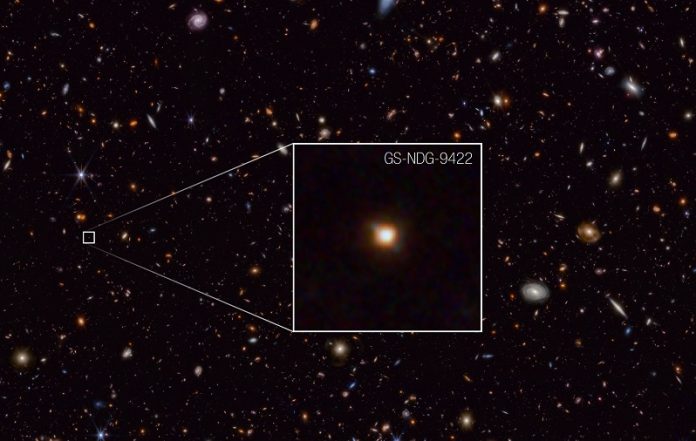
Astronomers have discovered a strange and unique galaxy in the early universe that could help us understand how galaxies evolved over time.
This galaxy, named GS-NDG-9422 (or 9422), was found about one billion years after the Big Bang and has a very unusual feature: its gas is shining more brightly than its stars.
This discovery was made by the James Webb Space Telescope (JWST), a powerful tool that allows scientists to look back in time and study the universe’s earliest moments.
GS-NDG-9422 stood out to researchers because it has a light signature that has never been seen before.
Normally, in galaxies, stars are the main source of light. However, in this galaxy, the gas surrounding the stars is brighter, which is highly unusual.
Dr. Alex Cameron, the lead researcher from the University of Oxford, described his reaction to this discovery as, “that’s weird,” which is exactly the kind of surprising find the Webb telescope was designed to reveal.
This galaxy might represent a missing link in our understanding of how galaxies evolved. The researchers believe that GS-NDG-9422 could be in a phase of evolution between the universe’s first stars and the galaxies we are familiar with today.
To better understand this, Dr. Cameron collaborated with Dr. Harley Katz, a theorist from Oxford and the University of Chicago.
They compared Webb’s observations with computer models of cosmic gas clouds heated by very hot, massive stars. The match was nearly perfect, suggesting that the stars in GS-NDG-9422 are much hotter and more massive than those in the modern universe.
Extremely hot stars
In our local universe, the hottest stars usually have temperatures between 70,000 and 90,000 degrees Fahrenheit (40,000 to 50,000 degrees Celsius).
However, the stars in GS-NDG-9422 are even hotter, exceeding 140,000 degrees Fahrenheit (80,000 degrees Celsius). The researchers think that this galaxy is in a short but intense phase of star formation.
Inside a dense gas cloud, many massive, hot stars are being born. These stars emit so many photons—particles of light—that the surrounding gas shines extremely brightly, even more so than the stars themselves.
A glimpse into the early universe
The discovery of GS-NDG-9422 is intriguing because it hints at conditions similar to those predicted for the universe’s first generation of stars, known as Population III stars.
These were the first stars to form after the Big Bang.
While GS-NDG-9422 does not contain Population III stars, its stars are still very different from those we see today. Understanding this galaxy could help scientists learn more about how galaxies transitioned from these primordial stars to the more familiar types of galaxies we see today.
GS-NDG-9422 is just one example of this strange phase in galaxy development, and there are still many questions to be answered. Are these conditions common in other galaxies from this time period, or is GS-NDG-9422 unique?
What more can this tell us about even earlier stages of galaxy evolution? Dr. Cameron, Dr. Katz, and their team are now searching for more galaxies like GS-NDG-9422 to deepen their understanding of what was happening in the universe within the first billion years after the Big Bang.
“It’s a very exciting time,” Dr. Cameron said, “We are just at the beginning of new discoveries and understanding.”



